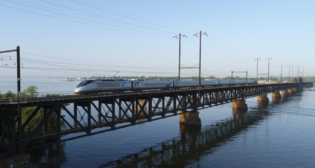
Keep railroads FREE to keep the economy moving
Written by William C. Vantuono, Editor-in-ChiefCongress, collectively, has “forgotten” the dark days of rail regulation and its own move to address it. That’s a threat to rail’s long-term viability.
If June 21, 1970, lives in infamy as the day railroad operator Penn Central declared bankruptcy, the date similarly symbolizes when opinion leaders and decision makers commenced to understand how decades of stultifying railroad economic regulation created a stable of fractured iron horses.
It would take another decade to begin restoring railroads to economic wellbeing and an ability to self-finance adequate infrastructure investment to meet efficiently the nation’s existing and growing freight transportation demands.
Yet some shippers most dependent on reliable railroad service are lobbying Congress, under the banner of Consumers United for Rail Equity (CURE), to roll back regulatory reforms that ended the industry’s stagnation — and solely for the short-term benefit of their own bottom lines.
To protect against a dismantling of the genuine “cure” for railroad ills past — the Staggers Rail Act of 1980 — and prevent an unwarranted return to the noxious regulatory actions that produced the sclerosis of America’s principal artery of commerce, a history lesson is in order. As 19th century philosopher George Santayana counseled, “Those who cannot remember the past are condemned to repeat it.”
Especially, the history lesson must be articulated on Capitol Hill, as of the 535 members of the House of Representatives and Senate, just five senators and 11 representatives held office when rail shippers, rail labor, rail management, investors, and a bipartisan majority in Congress came together in 1980 to support and craft the legislative remedy known simply as the Staggers Act — a law earning recognition as the most vital railroad legislation ever enacted.
Most in Congress today are not conversant with the dismal pre-Staggers era in which bureaucrats peered over the desks of railroad decision makers, numbing entrepreneurial energy and blunting managerial flexibility to respond quickly to changing market conditions. In the pre-Staggers era, railroads were required to petition government for permission to raise, as well as lower, freight rates; trim under-utilized assets; customize service to meet individual customer needs; and were prohibited from entering into confidential contracts with shippers.
It was an era when a single complaint to federal regulators would trigger an investigation so lengthy that by the time a ruling was rendered, the market changes generating the action had changed again.
Nor were most current members of Congress present during the pre-Staggers era to witness more than 20% of the nation’s rail route mileage tumbling into bankruptcy; a quadrupling of train accidents caused by track defects; 25% of rail route-miles restricted to speeds as slow as 10 mph over deteriorating track; an accumulation of $16 billion (in 2012 dollars) in deferred maintenance for track, yards, bridges, tunnels, and equipment; weeks-late arrivals at factories and stores of raw materials and consumer goods; and a flight from the rail industry of investment capital.
When Penn Central went bust, federally insured certificates of deposit were paying 11% and competing truckers were reporting even higher returns, yet the railroad industry’s rate of return on investment was less than 3%, with many railroads posting perennial deficits.
That some railroads remained financially sound was of minor consequence to a shipper on such lines whose freight was destined to a region served by a financially crippled railroad.
Adding to the squeeze of excessive regulation were subsidies to competing modes. While railroads bear the full costs of constructing, maintaining, and operating their rights-of-way, and paying property taxes on those privately held assets, competing trucks and barges utilize public rights-of-way constructed and maintained by federal and state governments. Although user charges are assessed truck and barge operators, they represent but a fraction of those assets’ cost.
Having not witnessed the railroads’ Dunkirk, today’s lawmakers are susceptible to the self-serving pleas of a handful of self-described captive rail shippers — many larger and more profitable than railroads on whose quality service they depend.
This small minority advocates a return to the era when railroads were required to make more distant producers competitive with local producers in given markets and to provide rate-preference to certain ports or regions. They want railroads to open their privately owned track for use by competing railroads, allowing others to benefit from the owning railroad’s investments. Open access would drive rail rates below market levels, causing railroads to lose substantial revenue that would reduce capital investment, encourage deferred maintenance that slows trains, and reverse improvements in customer service.
Those promoting the attack on the Staggers Act themselves disregard the history of a rapidly declining rail industry of the 1970s that beckoned nationalization. They ignore the lessons learned from Penn Central’s bankruptcy — a failure so massive it eclipsed every previous American business bankruptcy. It was as stark a shock in 1970 as the 2008 Lehman Brothers failure precipitating the more recent economic downturn, requiring a massive bailout of the financial services industry.
It was estimated by the Federal Railroad Administration that nationalizing railroads in 1970 would have cost the federal government almost $600 billion in 2012 dollars — not counting the hundreds of billions more likely to be required by retaining the status quo under federal ownership.
Initially, Congress applied bandages to stanch the railroads’ financial hemorrhaging.
Federally owned Amtrak was created, relieving railroads from operating money-losing intercity passenger service that was draining from them hundreds of millions of dollars annually.
The Regional Rail Reorganization (3-R) Act created federally owned and subsidized Conrail out of the ashes of Penn Central and four other Northeast bankrupt railroads. Congress authorized hundreds of millions of dollars in loans and loan guarantees to permit other failed and failing railroads to continue operating.
Railroad income statements and balance sheets continued to deteriorate. “The whole system of capitalism was careening,” wrote then-Railway Age Editor Luther Miller. Substandard earnings were sending investors fleeing, and deteriorating railroad service was adversely affecting manufacturing, assembly lines, and U.S. international trade.
As many shippers abandoned railroads in favor of faster and more dependable pavement-pounding and less environmentally friendly trucks traveling federally constructed and subsidized highways, rail-dependent coal, chemical, and grain shippers faced the prospect of paying soaring freight rates to finance an even less-utilized track network starved of capital investment. This is because when rail traffic drops, fixed costs such as those for signals, routine maintenance, structures, rents, debt repayment, taxes, and other overhead do not decline as shipments fall.
In the quarter century leading up to 1970, truck tonnage had soared by 200%, while rail tonnage grew by just 16%. As the railroad share of intercity freight ton-miles declined from 69% to 36%, the truck share climbed from under 1% to 24%. If capital-intensive railroads — where some 45 cents of every revenue dollar must be invested back into plant and equipment — were to survive as privately owned entities, their high fixed costs had to be recovered from growing the business; and profitability had to improve to attract new capital investment to fund productivity, technological advancements, and improved service quality.
As the railroad situation worsened, and bankruptcies multiplied, the words from President Kennedy’s 1962 transportation message gained renewed attention: Railroads were subject to “excessive, cumbersome, and time consuming regulatory supervision that shackles and distorts managerial initiative.”
By 1976, with no meaningful railroad recovery in sight, Congress passed the Railroad Revitalization and Regulatory Reform (4-R) Act, which offered an initial dose of economic deregulation. Dispatched to the dust bin of history was rate regulation serving “little or no useful public purpose.” The 4-R Act also ordered regulators to consider revenue needs of railroads, liberalize constraints on abandoning light-density track, and speed the process for mergers promising greater efficiencies. It also prohibited states and local governments from imposing discriminatory taxes on railroad property.
It still was not enough. With many railroads continuing to lose money, a fog of despair continued to envelope the industry. Certainty had set in that throwing federal money at the problem and providing limited doses of economic deregulation were insufficient to save the patient.
Despondent rail-dependent shippers joined the collaborative effort to replace the still lingering command-and-control regulatory template with a more free-market based model.
The Edison Electric Institute, which represents many shippers now seeking a rollback of Staggers Act freedoms, told Congress that “regulators must balance their efforts to keep down immediate consumer costs against the even more important responsibility to assure adequate service.”
So was born the Staggers Rail Act of 1980, named after one of the law’s strongest proponents — the longtime chairman of the House Commerce Committee, Rep. Harley O. Staggers (D-W.Va.), who was retiring from Congress.
The fundamental purpose of the Staggers Act was to recognize a Jeffersonian ideal that “the merchants [in this case, railroads] will manage commerce the better the more they are left free to manage for themselves.”
Congress, having determined that arcane, antiquated, and rigid economic regulation was a malefactor intended the Staggers Act to establish market forces as the primary arbiter of freight rates, track abandonments, and marketing initiatives. The law also was recognition that the significant market power held by railroads in the late 19th and early 20th centuries had been eroded by alternative forms of federally subsidized transportation facing less burdensome regulation.
The Staggers Act did not fully deregulate railroads. If a railroad rate exceeds a statutory threshold, regulators can prescribe a maximum rate retroactively. Of 45 complaints filed with the Surface Transportation Board since 1996, shippers prevailed 11 times and railroads eight, while the remaining 26 complaints were settled voluntarily.
In passing the Staggers Act, Congress decreed that competition and the demand for service should determine rail freight rates “to the maximum extent possible.” Railroads were to be given an opportunity to earn adequate revenue and attract the necessary new investments to renew facilities, compete with alternative forms of transportation, and improve service levels within the framework of a competitive marketplace.
The Staggers Act specifically excluded from further regulation freight interchangeable between railroads and trucks, such as railroad boxcar traffic and freight moving in highway trailers and marine containers riding atop flat cars (intermodal).
Railroads responded with innovative price and performance packages that, despite a 1981 recession, resulted in rail intermodal shipments increasing by 3% while motor carrier tonnage declined by more than 15%. This contrasts with pre-Staggers 1975 (another recession year) when intermodal traffic declined by 19%. In the years following the 1980 Staggers Act, railroads, which during the 1970s had lost to trucks all trailer loads of fresh fruits and vegetables, regained tens of thousands of those shipments. Since 1980, railroads have almost quadrupled their volume of intermodal traffic to near 12 million units annually.
Utilizing another Staggers Act freedom, railroads negotiated confidential transportation contracts with shippers that guarantee rate and performance levels. Initially, railroads entered into lengthy — sometimes 20-year — contracts with coal shippers at rates reflecting a need to generate more traffic.
Many of those contracts were negotiated at prices reflecting substantial excess track capacity — existing because regulators had repeatedly denied efforts to abandon under-utilized track. More than a third of rail route-miles had carried just 1% of the freight and there was pressing need to increase volume.
As those lengthy-term contracts expired, railroads sought higher rates to reflect the elimination of excess capacity and their increased costs for fuel, labor, and technologically improved locomotives and safety appliances. Cries from some rail-dependent shippers for contract prices of a bygone era ignore economic reality.
Another economic freedom permitted by the Staggers Act — one typical in other industries — is to permit differential pricing, meaning different rates for different customers shipping the same commodities or receiving the same service. Electric utilities attacking differential pricing themselves charge different rates for identical kilowatt hours delivered to residential and industrial customers.
An assertion by some shippers that railroads are exempt from antitrust laws is not accurate. Railroads are subject to antitrust laws barring collusion in rate making, market allocation, and unreasonable restraint of trade. Limited exemptions are for activities subject to oversight by the Surface Transportation Board. Were the limited exemptions repealed, railroads would face dual jurisdiction — a two-master conundrum of potentially conflicting STB and federal courts oversight that doesn’t exist for any other transportation mode.
Results matter, so let’s look more closely at the three decades since passage of the Staggers Act, during which a railroad renaissance has emerged and no major railroad has filed for bankruptcy.
Inflation-adjusted rail rates, on average, have declined almost 50% since 1981, saving shippers and consumers billions annually in lower shipping costs. Inflation-adjusted coal, chemical, and grain rates have declined, on average, between 26% and 49% since 1981.
Truck, barge, product, and geographic competition hold most rail rates in check, with the STB the arbiter if rail rates exceed a statutory threshold.
Product competition means substituting one product for another, such as natural gas for coal in electric power generation. Geographic competition means obtaining the same product —such as coal and grain — from different places served by another railroad. Shippers also generate competition through threatened or actual plant relocation.
Accumulated deferred maintenance no longer exists, and a revitalized rail infrastructure is meeting shippers’ just-in-time inventory demands.
Since 1980, railroad have invested more than $500 billion in plant and equipment, including visual, temperature sensitive, and acoustical wayside detectors to identify defects in passing railcars; more fuel efficient, higher-horsepower and computer-laden locomotives; ground penetrating radar to identify track stability problems; remote control operation in switching yards; more effective electronic braking systems; and advanced computer technology to forecast, plan, and dispatch on-time train arrivals. Installation before 2016 of Positive Train Control — a safety overlay controlled by computers and satellites — has a $10 billion price tag.
For 2013, BNSF, CSX, Kansas City Southern, Norfolk Southern, and Union Pacific announced they will invest some $13 billion in plant and equipment renewal and upgrades, including new facilities to handle growing freight transportation demands. These and future investments are at risk should Congress rollback the regulatory freedoms contributing to the renewed financial health of the industry.
Encouraging these capital investments has been a necessary improvement in the railroads’ return on investment (ROI), which has increased from under 3% in the 1970s to between 9.9% and 11.3% in all but one year since 2006 — about on par with American industry generally. When ROI is equivalent to the cost of obtaining investment capital, railroads are judged by the STB to be revenue adequate. The industry is approaching revenue adequacy, and several railroads have posted revenue adequate ROI in one or more years since 2004. A rollback of Staggers Act freedoms threatens revenue adequacy and the willingness of investors to provide additional capital.
As sure as Monday follows Sunday, rail-dependent shippers stand to suffer most if Staggers Act freedoms are dismantled, capital investment is curtailed, and deferred maintenance returns.
As Teddy Roosevelt — no slouch when it came to harnessing market power — counseled, “We must insist that when anyone engaged in big business honestly endeavors to do right, he himself shall be given a square deal.” The Staggers Act is that square deal.



